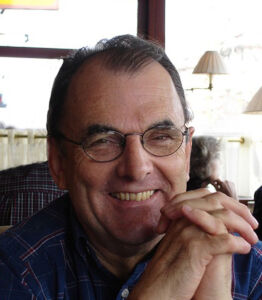I have been fortunate enough to have known Bryan Avery for the last 20 years, but it is hard to do justice to that friendship in a few minutes. The way he informed my architectural career will be shared with the many who passed through Avery Associates; Bryan’s unique philosophy of architecture has influenced a new generation to become successful architects and to develop their own practices. When I joined Avery Associates in the summer of 1997, it was at one of the busiest points in the practice’s history, and certainly a very memorable time.
Work was in progress on the exciting Royal Academy of Dramatic Art theatre project, squeezed into the extraordinarily tight Gower Street site. There was a long design development period to determine the form of the performance space. Richard Attenborough was one of the main advisors on the client’s team, and when a decision about the best theatre design had to be made, Bryan had his own vision but the theatre consultants had another. So Bryan came up with three cardboard models representing three different visions, only one of which was his own. Lord Attenborough asked the actor Alan Rickman to have a look at the models to decide which he thought would be best. Alan came to our office, which of course got everyone excited. He looked at the three models for a couple of minutes and then pointed to one model saying ’this one is hot’ and to another model saying ’this one is cool’. Not sure if hot or cool was best, Bryan checked with him and to his delight Alan had chosen Bryan’s vision as the hot and preferred model.
So Bryan’s team for RADA, a talented group including Amanda Henderson, Garry Reynolds and Phil Coffey, started work on the project in earnest. Much to my wife’s annoyance, I got to briefly meet Alan Rickman at an event at RADA some years later, and I was genuinely surprised that he really did have a wonderful voice offscreen. After Bryan met Gabby in 1999, he invited her out for dinner, but en-route to the restaurant he made a small detour to the building site of RADA. Wearing a far too big hard hat – safety first! – she received her first tour of RADA. I guess she knew what she was letting herself in for right from the start.
Alongside the RADA project, the detail design of the British Film Institute’s IMAX Cinema in Waterloo for the British Film Institute was also in full stream during 1997 and ‘98. As was the case with so many of Bryan’s commissions, it was the most complex of sites in the middle of a roundabout, surrounded by busy road traffic and rumbling trains, and sat on top of a raft of underground infrastructure! The steeply raked auditorium provided the largest screen in Britain, and I remember the challenges of faxes coming through from IMAX’s Canadian offices at all hours to try and coordinate the precise technical requirements for the IMAX system, and incorporating them into the pure circular plan of the building. I particularly recall the ever-patient John Neville-Jones, Marcus Wilshere and Matt Cartwright amongst others who somehow managed to turn the incredibly rigorous geometry into sets of tender and construction documents!
Supporting the architectural staff, the long service of Bryan’s excellent gatekeeper Jenny Witchell enabled him to have time to create his concepts and draw detail sketches uninterrupted in his then smoke-filled office.
Most people will know the IMAX for the crisply detailed glazed drum which created a new landmark for Waterloo, and Bryan was delighted when Sir Howard Hodgkin created the first artwork for the 360 degree elevation. It was always a huge regret to him when the IMAX turned the public art into London’s largest advertising hoarding. Bryan’s friend Takashi has created an Ikebana flower arrangement in the shape of the IMAX, located at the rear of the church today.
Bryan was always keen to remind the team about his high expectations for attention to detail, especially when it came to his love of geometry. Many a wall or door was briefly moved during detail design coordination to suit another consultant’s suggestion, only for it to be swiftly moved back if it impinged on an important element of the project’s composition. I recall one incident where we had a bit of an altercation over a couple of millimetres causing a lack of perfect symmetry – both of us knowing that on site it would not really matter, but Bryan’s rigour on detail design and pure geometry was literally down to the last millimetre!
One of the challenging tasks for a lucky year out student was to be asked to undertake the annual Christmas Card, a tradition that gave Bryan an opportunity to refine his thoughts on the Golden Section and the relationship to the double square that ran through so much of his thinking. Not to mention that attention to detail down to the very last millimetre!
Christmas 1997 will be memorable for many of us: the office trip to Paris was quite an occasion – celebrating a hard but successful year on the IMAX and RADA projects – and it happened to precede my wedding by a few days, so turned into my office stag do! A little architecture, good food, great drink followed by the thentraditional cigar.
Bryan’s studio was always about more than delivering thoughtful architecture to enlightened clients: he could visualise an architecture that went beyond style, he endeavoured to create “delight”. His consideration of how many of the building’s users would experience the space was very important, from both an architectural and usability perspective.
To many clients, a bespoke architectural response to a tricky site or brief is the only answer, but many clients do not allow the time or have the inclination to test out ideas, or fear the “risk-taking”, which was a disappointment on several exciting proposals over the years. For those who understood what Bryan offered, they got a fabulous result, with “delight” thrown in: such as RADA’s dramatic cleft that allowed the midsummer shaft of sunlight to fall on the George Bernard Shaw statue (and the jolly soirées to accompany the phenomenon).
Bryan was particularly proud of the Repton School Theatre in Derbyshire, a gem of a project, drawing on much of the success of the RADA theatre, not only delivered on time and on budget, but with panache and detailing that belied the challenging brief, context and budget. Bryan, always thinking of ways to connect people, even put the teachers at Repton in touch with staff at RADA.
Bryan’s rigorous approach to design grew out of a cornucopia of influences and precedents, from architectural masters such as Frank Lloyd Wright and Le Corbusier to classical exemplars such as Hadrian’s Villa in Tivoli or this wonderful church we are in today by Wren. Not only architecture though – Bryan was forever sketching the natural world and high-tech engineering; from the New Forest and Solent forts spotted during his long walks, to the detailing of military aircraft and shipping.
Many of Bryan’s colleagues will recall the wide-ranging conversations over a pint or three in the CASK, his local pub in Pimlico, and it was during these times that one got to know him a little better; from his early road trip days in the United States and his enjoyment in experiencing Frank Lloyd Wright for the first time, to his observations and love for the Greek Islands. If you were lucky, the conversation would develop over fish and chips in his favourite local restaurant… and topics from the planning system, to future travel plans, to national politics, to the RIBA and quality of architectural teaching would be energetically debated.
Over the last few years, the office has been lucky to have Anthony Carlile, providing Bryan with a right-hand man. This has been so important, allowing Bryan time to synthesise his architectural philosophy into something he called the Seven Cs. Bryan thoroughly enjoyed his international lectures, giving the last one only in March this year at the McGill University in Montreal, inspiring the next generation of architectural students with his design theory: ideas such as Wilderness City still, in my view, have significant resonance in the current debate on the country’s housing challenge.
Incidentally, his 2011 book Fragments of Wilderness City is still available on Amazon if you never got around to getting a copy when it was published. I recall the agonising debates on the page layouts and formatting, every single one checked by Bryan for adherence to the Golden Section and the setting out grid! It also features an introduction by Richard Weston, a good friend to Bryan over the years, providing a sounding board and advice.
Bryan was one of the most innovative and thought-provoking architects of his generation, and it was fabulous news when he was awarded the MBE for services to architecture in 2015. One can imagine the trepidation and nervousness when he saw that Prince Charles would be undertaking the ceremony, given the Prince’s previous history with modern architecture. When it came to Bryan’s presentation, Prince Charles asked him if he was still practising architecture. Bryan responded that yes, he was still practising and that he was still getting better at it – after which there was a right royal guffaw! I know that Bryan was rightly proud of that recognition. Bryan – so accurately called the “thinking man’s architect” in one of your obituaries – I will miss our working together, our conversations, pints and debates. The two Millennium Product Awards you received, were described as being awarded for “imagination, ingenuity and inspiration” as well as “innovation, creativity and design”: nothing could be more apt.
Bryan; your profession, your friends and your family will deeply miss you.



